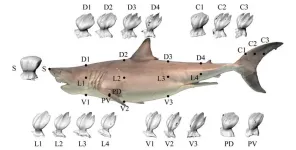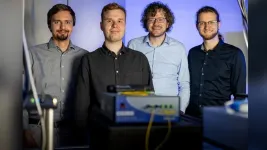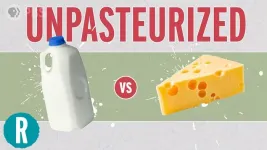(Press-News.org) AMES, Iowa – Researchers have been studying the industrial production of ammonia for a century. But they’ve struggled to find ways to improve the low-yield, low-efficiency process.
Atmospheric nitrogen, with the aid of an iron catalyst, reacts with hydrogen to produce ammonia. That reaction produces lots of ammonia – worldwide production is 160 million tons every year. Most is used in agriculture, especially as nitrogen fertilizer. It’s also used in many industries, including refrigeration for food and beverage production. We all know it as a household cleaner.
A research team led by Qi An, an associate professor of materials science and engineering at Iowa State University, has developed artificial intelligence technology that could find ways to improve researchers’ understanding of the chemical reactions involved in ammonia production and other complex chemical reactions.
“Our developed HDRL-FP framework has the potential to contribute significantly to the optimization of this process, potentially reducing production costs and CO₂ emission, and facilitating the establishment of smaller and more widespread plants,” the researchers wrote in a paper recently published online by the journal Nature Communications. “Therefore, the framework highlights its effectiveness and potential for predicting complex chemical reaction pathways.”
HDRL-FP is High-Throughput Deep Reinforcement Learning with First Principles. An and his collaborators and co-authors – Tian Lan and Huan Wang of Salesforce AI Research in California – say the technology is full of potential.
“Exploring catalytic reaction mechanisms is crucial for understanding chemical processes, optimizing reaction conditions, and developing more effective catalysts,” they wrote.
Of rewards and atoms
An said there are two keys to the researchers’ software technology: a type of machine learning called reinforcement learning and connecting the simulation process with the positions of the atoms involved.
An said reinforcement learning is like training a dog by using rewards to encourage actions. In reinforcement learning, computers learn from their actions while seeking appropriate rewards. In this case, the rewards are all about finding the best, most-efficient, lowest-cost reaction path.
The method, when used with graphics processing units and high-throughput strategies, can quickly and automatically identify the optimal reaction pathway from thousands of potential pathways, An said. That effectively identifies viable reaction mechanisms amidst the extremely noisy data in real chemical reactions.
The researchers also built the technology to be useful for general studies of catalytic reactions. Studies start with the positions of atoms mapped on an energy landscape. That’s enough – researchers don’t have to start with a more specific representation of the reaction environment, including the states, actions or rewards for a particular reaction.
An and his collaborators have worked on the project for about two years. It started when An moved to Iowa State and has been supported by his university startup funds.
He said the system’s calculations for the reaction producing ammonia is considered a proof-of-concept demonstration.
“This allows us to figure out the reaction mechanism,” An said. “We’re able to see important reaction steps in ammonia synthesis.”
The researchers’ successful peek inside that reaction “enables the investigation of complex catalytic chemical reactions automatically,” they wrote, “offering a promising approach for future research and discoveries.”
– 30 –
Read the paper: “Enabling high throughput deep reinforcement learning with first principles to investigate catalytic reaction mechanisms,” Nature Communications, July 25, 2024, https://doi.org/10.1038/s41467-024-50531-6
END
Engineers develop general, high-speed technology to model, understand catalytic reactions
2024-08-05
ELSE PRESS RELEASES FROM THIS DATE:
New $1.9 million PSU grant aims to improve outcomes for students with disabilities
2024-08-05
Improving outcomes for students with disabilities as they transition from high school to postsecondary education and employment starts with effective training and development opportunities for the secondary educators who support them.
Portland State University (PSU) has received a $1.9 million grant to redesign, implement and test a professional development model that aims to provide essential training for secondary educators. The grant, awarded by the U.S. Department of Education’s prestigious Institute of Education Sciences, will fund a four-year project titled "Transition Coalition Self-Study Plus (TCSS+): A ...
In law enforcement, a link between head injuries and depression, PTSD
2024-08-05
COLUMBUS, Ohio – A new study is the first to shed light on the high prevalence of head injuries, and related mental health symptoms, in a previously overlooked population when it comes to concussion surveillance: law enforcement officers.
The survey of Ohio law enforcement officers found that 74% reported a lifetime history of one or more head injuries, and 30% had a head injury that happened on the job. Many more of these injuries went unreported than were treated by a health care professional. And further analysis showed post-traumatic stress disorder and depressive symptoms were higher in those who had experienced one or more head injuries.
“This ...
Successful pregnancies after allogeneic hematopoietic cell transplantation – results of a national study
2024-08-05
A new national multicenter study offers hope for women who have undergone allogeneic hematopoietic cell transplantation (alloHCT). The results of the study, recently published in the renowned journal Blood, show that successful pregnancies are possible under certain conditions, especially in younger women, patients with non-malignant diseases, and those who received no or only low doses of total body irradiation (TBI).
For many benign hematologic disorders, allogeneic hematopoietic cell transplantation (alloHCT) is the only ...
Sanders-Brown Center on Aging launches innovative Brain Health Activities program
2024-08-05
LEXINGTON, Ky. (Aug. 2, 2024) – The University of Kentucky’s Sanders-Brown Center on Aging has introduced a groundbreaking initiative, Brain Health Activities, aimed at supporting individuals with dementia and their caregivers. The program was developed with extensive collaboration across the UK campus, offering a variety of resources designed to enhance brain health and quality of life for those affected by dementia and their caregivers.
The idea for ...
Nature's design marvel: How shark skin's denticles adapt to wide speed
2024-08-05
New findings on how sharks achieve drag reduction could inspire the design of riblets for more efficient aircraft and boats. In their investigation of great white shark denticles, researchers from Tokyo Tech found that ridge height and spacing play crucial roles in drag reduction at different swimming speeds. Higher middle ridges aid sharks in efficient cruising at slower speeds, while the lower side ridges become more critical for drag reduction during high-speed hunting bursts. The analysis also suggests that the speeds of an extinct giant ...
Ultrafine particles linked to over 1,000 deaths per year in Canada’s two largest cities
2024-08-05
A first-of-its kind study conducted in Canada’s two largest cities by McGill-led researchers has linked about 1,100 premature deaths per year to an unregulated air pollutant.
Ultrafine particles (UFPs) primarily come from vehicle emissions and industrial activities. Canada’s federal and provincial governments have not set concentration limits for UFPs, as they have for larger fine particles known as PM2.5.
“Ultrafine particles are incredibly small, allowing them to penetrate deep into the lungs and enter the bloodstream. Increasing evidence suggests these pollutants may contribute to heart and lung diseases, as well as certain forms of cancer,” ...
Physicists develop new method to combine conventional internet with the quantum internet
2024-08-05
Four researchers from the Institute of Photonics at Leibniz University Hannover have developed a new transmitter-receiver concept for transmitting entangled photons over an optical fiber. This breakthrough could enable the next generation of telecommunications technology, the quantum Internet, to be routed via optical fibers. The quantum Internet promises eavesdropping-proof encryption methods that even future quantum computers cannot decrypt, ensuring the security of critical infrastructure.
"To make the quantum Internet a reality, we need to transmit entangled photons via fiber optic networks,” says Prof. Dr. Michael Kues, Head of the Institute ...
Don't drink raw milk. But what about raw milk cheese? (video)
2024-08-05
WASHINGTON, Aug. 5, 2024 — A lot of people on the internet have been telling our host Alex to drink raw milk. This is a bad idea — a particularly bad one actually. So she wanted to make a video about why it’s such a bad idea to consume raw milk, then she realized she’s been eating raw milk without even knowing it via cheese. That’s when things got complicated.
Reactions is a video series produced by the American Chemical Society and PBS Digital Studios. Subscribe to Reactions and follow us on X, formerly Twitter @ACSReactions.
The American Chemical Society ...
Does transparency help or hurt businesses dominated by one-time transactions
2024-08-05
DALLAS (SMU) – It’s a relevant question for business owners with few repeat customers, such as contract workers or real estate agents: Does being transparent about past business transactions change the odds of making a sale that benefits both buyer and seller?
The answer matters because mutually beneficial sales ensure that these kinds of transactions will continue, keeping the economy strong.
A new study published in the journal American Economic Review suggests the answer depends on a variety of factors.
A mutually beneficial sale is defined from two points of view: The seller values the money they receive more than ...
Insufficient evidence to recommend low-dose CT screening in never smokers lung cancer screening: new insights and ongoing debates
2024-08-05
(Denver, Colo.—August 5, 2024) – Lung cancer remains the leading cause of cancer-related deaths worldwide. Detecting this disease in its early stages significantly improves survival rates, making low-dose CT screening an essential component in the fight against lung cancer. Recent studies, particularly from Asia, have sparked a debate on whether these screening benefits extend to non-smokers and those with minimal smoking histories.
However, according to an article published in the Journal of Thoracic Oncology, there is currently insufficient evidence to support ...





